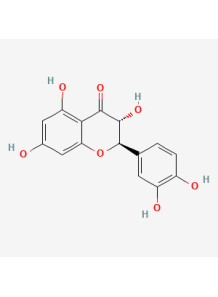Dihydroquercetin (Taxifolin, 98%)
- Product Code: 11201
Flavonoid compounds found in many plants, fruits, and vegetables. It is a dihydro derivative of quercetin, a well-known antioxidant and anti-inflammatory agent.
- -
- -
- -
- -
- -
- -
- -
- -
- -
- -
- -
- -
- -
- -
- -
- -
- -
- -
| Test Name | Specification |
|---|---|
| Appearance | Light yellow to off-white powder |
| Assay | =>98.0% |
| Odor | Characteristic |
| Loss on drying | =<5.0% |
| Ash | =<5.0% |
| Pb | =<2.0 ppm |
| Cd | =<1.0 ppm |
| As | =<2.0 ppm |
| Hg | =<1.0 ppm |
| Total Plate Count | <1000 cfu/g |
| Yeast and Mold | <100 cfu/g |
| E. coli | Absent |
| Salmonella | Absent |
| S.aureus | Absent |
Dihydroquercetin (taxifolin) is a flavonoid compound found in many plants, fruits, and vegetables. It is a dihydro derivative of quercetin, a well-known antioxidant and anti-inflammatory agent.
There have been some studies done on the health benefits of dihydroquercetin. which suggests it might be useful, such as:
Anti-inflammatory: Dihydroquercetin has been found to have anti-inflammatory properties. This may be beneficial in treating conditions such as rheumatoid arthritis. Osteoarthritis and inflammatory bowel disease
Antioxidant: Dihydroquercetin It has antioxidant properties that may help protect the body from damage caused by free radicals.
Anticancer Properties: Dihydroquercetin It has been found to have anti-cancer properties. This has been shown to inhibit the growth of cancer cells in laboratory studies.
Cardiovascular Health: Dihydroquercetin Beneficial to the heart and blood vessels Lower blood pressure Improves endothelial function and reduces the risk of heart disease.
Antiviral Properties: Dihydroquercetin It has been found to have antiviral properties. It has been shown to inhibit HIV-1 virus replication in laboratory studies.
Currently, the FDA has not allowed this product to be used in dietary supplements. Used for research experiments For future food only
Be the first to review this product :-)
Recommend Lab-Service
| Lab Service | Price |
|---|
Flavonoid compounds found in many plants, fruits, and vegetables. It is a dihydro derivative of quercetin, a well-known antioxidant and anti-inflammatory agent.
Dihydroquercetin (taxifolin) is a flavonoid compound found in many plants, fruits, and vegetables. It is a dihydro derivative of quercetin, a well-known antioxidant and anti-inflammatory agent.
There have been some studies done on the health benefits of dihydroquercetin. which suggests it might be useful, such as:
Anti-inflammatory: Dihydroquercetin has been found to have anti-inflammatory properties. This may be beneficial in treating conditions such as rheumatoid arthritis. Osteoarthritis and inflammatory bowel disease
Antioxidant: Dihydroquercetin It has antioxidant properties that may help protect the body from damage caused by free radicals.
Anticancer Properties: Dihydroquercetin It has been found to have anti-cancer properties. This has been shown to inhibit the growth of cancer cells in laboratory studies.
Cardiovascular Health: Dihydroquercetin Beneficial to the heart and blood vessels Lower blood pressure Improves endothelial function and reduces the risk of heart disease.
Antiviral Properties: Dihydroquercetin It has been found to have antiviral properties. It has been shown to inhibit HIV-1 virus replication in laboratory studies.
Currently, the FDA has not allowed this product to be used in dietary supplements. Used for research experiments For future food only
| Mechanism | - |
| Appearance | - |
| Longevity | - |
| Strength | - |
| Storage | - |
| Shelf Life | - |
| Allergen(s) | - |
| Dosage (Range) | - |
| Recommended Dosage | - |
| Dosage (Per Day) | - |
| Recommended Dosage (Per Day) | - |
| Mix Method | - |
| Heat Resistance | - |
| Stable in pH range | - |
| Solubility | - |
| Product Types | - |
| INCI | - |
Cart
No products



